Carpenter Ant
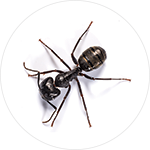 Color: Usually red, black or a combination
Color: Usually red, black or a combination
Legs: 6
Shape: Segmented with 3 main body regions
Size: ¼ – ¾ inch long
Antennae: Yes and may have wings
Region: Found throughout the U.S.
Carpenter ants get their name because they excavate wood in order to build their nests. Their excavation results in smooth tunnels inside the wood. Sometimes there will small piles of sawdust associated with their nest building. If you look closely, you will see dead insects and insect parts mixed in with the wood shavings.
Habits
Carpenter ants typically attack wood that is or has been wet. They usually come into structures through cracks around doors and windows, holes in a structure meant for wires or through wet, damaged wood. They will also crawl along overhead wires, shrubs or tree limbs that touch the building far above the ground. Carpenter ants build their nests in various wood sources including tree stumps, fence posts, firewood or landscaping. A colony can have multiple nests inside structures as well as outdoors.
Habitat
Carpenter ants build their nests outdoors in various wood sources including tree stumps, firewood or landscaping. They also can build nests in voids like hollow core doors or curtain rods. They may build a satellite nest in structures in a void or wood, especially wood that may have been damaged by water.
Threats
Carpenter ants damage wood through their nest building and do not feed on the wood. Over time, an infestation can cause serious structural damage to a property.
Prevention
Carpenter ants require a water source. To help prevent carpenter ants, reduce sources of moisture including pipe leaks and rain water drainage issues. Keep tree branches and other plants cut back from the building. Sometimes pests use these branches to get inside. Make sure that there are no cracks or small openings around the foundation of the building. Make sure that firewood and building materials are not stored directly next to the structure or home. Carpenter ants may build nests in stacks of wood.
Pavement Ant
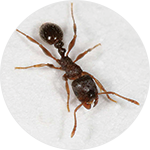 Color: Dark brown to blackish
Color: Dark brown to blackish
Legs: 6
Shape: Segmented with 3 main body regions
Size: 1/16 – 1/8 inch long
Antennae: Yes
Region: Found throughout the eastern half of the U.S. and they are one of the most common ants in the Midwest.
Pavement ants get their name because they make their nests in or under cracks in pavement. However, they can also infest structures. Pavement ant colonies are moderately large, averaging around 4,000 workers with several queens. They often can be recognized by the small mounds of dirt they excavate in the soil where they are nesting.
Habits
These ants will eat almost anything, including other insects, seeds, honeydew, honey, bread, meats, nuts and cheese. In buildings, they are most likely to be found in ground-level masonry walls of foundations, but they will occasionally nest in walls, insulation and under floors, and near heat sources in the winter. They enter through cracks in the slab and walls, as well as through natural openings. Outside, these ants typically nest under stones, pavement cracks and next to buildings.
Habitat
In buildings, pavement ants are most likely to be found in ground-level masonry walls, but they also nest in walls, insulation and under floors. Outside, these black ants typically nest under stones, pavement cracks and next to buildings.
Threats
Pavement ants do not pose a public health risk, but they can contaminate food and should be avoided.
Prevention
Pests such as pavement ants, are attracted to moisture. To prevent pavement ants, eliminate standing water around the structure. Keep tree branches and other plants cut back from the structure or home. Make sure that there are no cracks or small openings around the foundation. Indoors, clean up spills and crumbs on counter tops and floors.
Argentine Ant
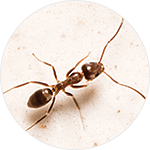 Color: Light to dark brown in color
Color: Light to dark brown in color
Legs: 6
Shape: Segmented with 3 main body regions
Size: 1/16 of an inch
Antennae: Yes
Region: Mainly Southeastern and Southwestern U.S.
Argentine ant colonies can grow to monumental size. A single colony can contain several hundred thousand workers with the colony borders sometimes cover entire habitats. These dark brown to black ants give off a musty odor when crushed.
Habits
Argentine ants prefer to eat sweets, but they will eat almost anything including meats, eggs, oils and fats. They will feed on honeydew secretions that are produced by insects such as aphids. They will create trails when foraging for food for other colony members to follow. These foraging trails can be as long as 200 feet although typically the ants will nest close to their food source.
Habitat
Their colonies are usually found in wet environments near a food source. Outdoors, they usually build shallow nests under boards or stones, beneath plants or alongside sidewalks. When conditions in their natural environment are either too wet or too dry, Argentine ants may seek shelter indoors, where they often nest near water pipes, sinks or potted plants.
Threats
Argentine ants do not pose a health threat, but they can contaminate food and should be avoided.
Prevention
Pests, such as Argentine ants are attracted to moisture. Reducing moisture can help eliminate Argentine ants. Keep tree branches and other plants cut back from the structure or home. Sometimes pests like Argentine ants use these branches to get inside. Make sure that there are no cracks or little openings around the bottom of the foundation. Adverse conditions on the exterior can cause Argentine ants to migrate indoors.
Odorous House Ant
 Color: Black or brown
Color: Black or brown
Legs: 6
Shape: Segmented with 3 main body regions
Size: 1/16 – 1/8 of an inch
Antennae: Yes
Region: Found throughout the U.S.
The odorous house ant gets its name from the strong, blue cheese odor it gives off when crushed. These tiny brown ants range in size from one-sixteenth of an inch to one-eighth of an inch long.
Habits
Odorous house ants like to eat sweets, especially honeydew. Indoors, they are likely to nest near moisture sources, such as in wall voids near hot water pipes, in heaters, beneath leaky fixtures in bathrooms, under kitchen or bathroom sinks and also in wood damaged by termites. Outside, they are often found in exposed soil or under rocks, boards, or bricks. The workers will run in an erratic manner when they are alarmed with their abdomens in the air.
Habitat
Indoors, odorous house ants nest near moisture sources, such as in wall voids near hot water pipers, in heaters, beneath leaky fixtures and inside wood damaged by termites. Outside, odorous ants are often found in exposed soil or under stacks of firewood.
Threats
These ants do not pose a public health risk, but they can contaminate food and should be avoided.
Prevention
Pests such as odorous ants are attracted to moisture. To help prevent odorous house ants, correct moisture issues like leaky pipes or poor drainage. Keep tree branches and other plants cut back from the structure or home. Make sure that there are no cracks or small openings around the foundation that would permit ant entry.
Pharaoh Ant
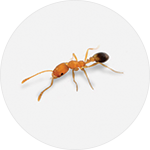 Color: Body usually pale, varying from yellowish to reddish with abdomen often darker to black
Color: Body usually pale, varying from yellowish to reddish with abdomen often darker to black
Legs: 6
Shape: Monomorphic with segmented body; 3 main body regions
Size: 1/16 of an inch
Antennae: Yes
Region: Found throughout the U.S.
Pharaoh ants get their name from the mistaken belief that they were one of the plagues of Egypt during the time of Pharaohs. This species is thought to be native to Africa, but is currently found throughout the Unites States.
Habits
Colonies of Pharaoh ants tend to be large, with workers numbering in the thousands. If disturbed, members of the colony will migrate to new locations to establish several new colonies through a process called budding. Pharaoh ants feed on a variety of food sources including sweets, oils and proteins. They will also eat other dead insects.
Habitat
Pharaoh ants are commonly found in commercial food handling establishments such as hotels, grocery stores, hospitals, and multi-unit dwellings. Inside, they nest in warm, humid areas near food and water sources. Nests are usually located in inaccessible areas such as wall voids, behind baseboards, in furniture and under floors. These ants often use electrical and telephone wires as a highway system to travel through walls and between floorboards. Outside, Pharaoh ants are typically found in shaded areas or under debris. They cannot survive outdoors year-round in the northern regions of the country.
Threats
Pharaoh ants have been implicated in the spread of more than a dozen disease pathogens including salmonella and Streptococcus pyogenes. They are notorious for being a major nuisance in hospitals where they can enter wounds, enter IV bottles and can sometimes even seek moisture from the mouths of sleeping patients.
Prevention
- Seal all possible points of entry around the house including small openings and cracks around doors and windows.
- Keep counters and floors clean and free of crumbs.
- Store food in airtight containers and dispose of garbage regularly in sealed receptacles.
- Eliminate sources of standing water outside and use a dehumidifier indoors to prevent moisture buildup.
- Keep tree branches and shrubbery well-trimmed and away from the building.
Little Black Ant
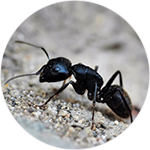 Color: Dark brown to black; typically jet-black
Color: Dark brown to black; typically jet-black
Legs: 6
Shape: Segmented with 3 main body regions
Size: 1/16 of an inch
Antennae: Yes
Region: Found throughout the U.S.
The little black ant gets its common name from its very small size and black coloration. Colonies are moderate to very large and contain many queens.
Habits
Little black ant swarms are common from June to August, during which time they forage in trails and are frequently seen along sidewalks. These small ants feed on grease, oil, meats, fruits and vegetables materials such as corn meal and sweets. The workers also feed on other insects, honeydew and plant secretions.
Habitat
Little black ants are common in wooded areas. In yards, they nest under rocks, in rotting logs and under piles of bricks or lumber. Indoors, nests are located in woodwork, wall voids, decaying wood, masonry and behind facades.
Threats
Although little black ants have a stinger, it is often too small and weak to be effective.
Prevention
To prevent a little black ant infestation, seal cracks and crevices in exterior walls and keep shrubbery well-trimmed. Location of the nest is also important. While it can be difficult to see these ants due to their small size, their nests can be found by following the trial of workers back to the colony.
